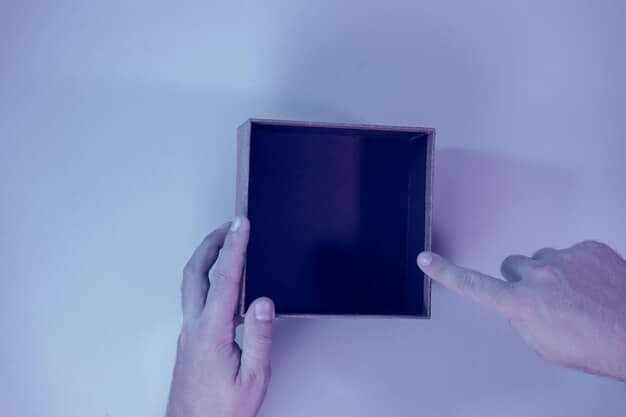ASMR & Social Media: Brand Engagement in 2025

ASMR and social media: how brands are leveraging sensory content for engagement in 2025 is transforming digital marketing, utilizing gentle sounds and visuals to evoke calm and connection, offering a unique avenue for deeper consumer interaction and brand loyalty in a crowded online landscape.
In the vibrant, always-evolving landscape of digital marketing, a subtle yet powerful phenomenon is reshaping how brands connect with their audiences: Autonomous Sensory Meridian Response, or ASMR. Once a niche online community, ASMR and social media: how brands are leveraging sensory content for engagement in 2025 has blossomed into a mainstream sensation, offering a unique pathway for engagement that transcends traditional visual and auditory stimuli. As we navigate towards 2025, understanding how companies harness these gentle whispers, delicate taps, and soothing visuals becomes crucial for any marketer aiming to forge deeper, more meaningful connections in a noisy digital world.
The Rise of ASMR: From Niche to Mainstream Marketing Tool
ASMR, often described as a static-like or tingling sensation on the skin that typically begins on the scalp and moves down the back of the neck and upper spine, is triggered by specific auditory or visual stimuli. It’s a phenomenon that has profoundly impacted digital content consumption. What started as an obscure corner of YouTube, populated by creators whispering into microphones or performing mundane tasks, has evolved into a significant cultural force and, more recently, a compelling marketing strategy.
The journey of ASMR from a fringe internet trend to a recognized marketing phenomenon underscores a deeper shift in consumer behavior. Audiences are increasingly seeking content that promotes relaxation, mindfulness, and a sense of calm amidst the constant bombardment of information. Brands, always quick to adapt, have recognized the immense potential of ASMR to tap into these consumer desires, creating unique, immersive experiences that go beyond mere visual appeal, fostering a strong emotional connection.
Understanding the ASMR Phenomenon and Its Appeal
The core appeal of ASMR lies in its ability to evoke a physiological and psychological response. For many, it offers a sense of tranquility and a pleasant escape from daily stressors. This calm state, combined with the focus on subtle, often overlooked sensory details, positions ASMR as a powerful tool for engagement. When a brand integrates ASMR into its marketing, it’s not just showing a product; it’s creating an atmosphere, a feeling, and an intimate moment with the consumer.
- Sensory Immersion: ASMR content provides a highly immersive experience, drawing viewers in through delicate sounds and focused visuals.
- Emotional Connection: Triggers like whispering, soft tapping, or gentle scratching can evoke feelings of comfort, safety, and relaxation, forging a deeper bond.
- Attention Spans: In a world of fleeting attention, ASMR’s slow, deliberate pace encourages longer viewing times and heightened focus.
- Novelty and Uniqueness: It offers brands a unique way to stand out from competitors, moving beyond traditional, often loud, advertising methods.
This inherent ability to capture and hold attention, paired with the positive emotions it typically elicits, makes ASMR an invaluable asset for brands aiming for authentic engagement. Its quiet nature cuts through the digital noise, offering a refreshing, almost meditative, alternative.
The Maturation of ASMR Content on Social Platforms
Since its early days on YouTube, ASMR content has diversified significantly. Beyond simple soundscapes, creators now produce elaborate videos showcasing product handling, unboxing, cooking, crafting, and even professional role-plays, all designed to trigger the calming sensation. This evolution means brands have a vast repertoire of ASMR techniques to draw from, allowing for creative integration that aligns with their brand identity and product offerings.
Social media platforms like TikTok, Instagram Reels, and even short-form YouTube videos have become fertile ground for ASMR’s expansion. Their emphasis on short, digestible, and highly shareable content aligns perfectly with the bite-sized nature of many ASMR triggers. This widespread accessibility has further cemented ASMR’s status as a legitimate and effective content format for reaching diverse audiences.
The transition from a niche phenomenon to a mainstream marketing tool reflects a broader understanding of human psychology and sensory marketing. Brands are no longer just selling products; they are selling experiences, emotions, and a sense of well-being. ASMR, with its inherent ability to deliver these intangibles, is perfectly positioned to lead the next wave of authentic brand engagement.
Strategic Integration: How Brands Are Using ASMR in 2025
By 2025, ASMR has moved beyond experimental campaigns to become a sophisticated component of brand communication strategies. Companies are no longer merely dabbling; they are carefully crafting ASMR experiences that resonate deeply with their target demographics, leveraging the unique sensory connection it offers. This strategic integration is multifaceted, incorporating various techniques and platforms to maximize impact and engagement.
One of the primary ways brands are utilizing ASMR is through product demonstrations and unboxing videos. The gentle sounds of packaging rustling, the soft clicks of components, or the smooth glide of a product being reveal are inherently satisfying for many viewers. This approach elevates the mundane into a captivating sensory journey, enhancing the perceived value and quality of the product even before it’s physically experienced. It’s a subtle form of persuasion that builds excitement and anticipation.
Enhancing Product Value and User Experience
ASMR’s ability to highlight subtle details makes it an excellent tool for showcasing product craftsmanship and texture. Imagine a luxury skincare brand demonstrating the smooth application of a serum, accompanied by the gentle squish of the product or the soft brush strokes. Or a food brand emphasizing the crunch of a biscuit or the fizz of a drink. These sensory cues do more than just inform; they create an empathetic connection, allowing the consumer to almost feel the product before they’ve touched it.
- Texture Emphasis: Brands use close-up shots and enhanced audio to highlight the tactile qualities of products, like the crinkle of a snack bag or the softness of fabric.
- Sound Design: Intentional sound design is crucial, turning industrial sounds or everyday noises associated with products into soothing ASMR triggers.
- Sensory Storytelling: Crafting narratives around the product that engage multiple senses, not just sight and sound, leading to a richer brand story.
- Interactive Experiences: Some brands are exploring interactive ASMR experiences, where users can choose their preferred sounds or visual pathways.
This focus on enriching the user experience transforms passive viewing into an active sensory immersion. It’s a powerful way to differentiate products in a crowded marketplace, appealing to consumers on a deeper, more primal level.

Building Brand Affinity Through Relaxation and Wellness
Beyond direct product promotion, many forward-thinking brands are leveraging ASMR to cultivate a holistic brand image associated with relaxation, wellness, and self-care. In a high-stress world, content that actively helps consumers de-stress positions a brand as a source of comfort and tranquility. This approach is particularly effective for industries like beauty, health, home goods, and even financial services seeking to build trust and calm.
For instance, a meditation app might release ASMR-infused guided meditations, or a tea company could create content focusing on the soothing sounds of brewing and pouring tea. These initiatives don’t directly sell a product, but they foster strong positive associations with the brand. They create a “safe space” online where consumers feel understood and cared for, leading to increased brand loyalty and a stronger sense of community. This subtle branding builds affinity and trust, turning consumers into advocates.
Furthermore, ASMR content fosters longer engagement times. Unlike quick, punchy ads, ASMR videos encourage sustained viewing, allowing brands more time to convey their message and reinforce their identity. This extended exposure, combined with the positive emotional state induced by ASMR, creates a memorable and impactful brand impression. The strategic integration of ASMR isn’t just about going viral; it’s about building lasting relationships grounded in sensory pleasure and emotional well-being.
The Psychology Behind ASMR Marketing: Why It Works
The effectiveness of ASMR in marketing campaigns isn’t merely anecdotal; it’s rooted in fascinating psychological principles that tap into fundamental human responses. Understanding these underlying mechanisms is crucial for brands looking to leverage ASMR content authentically and effectively in 2025. It’s not just about making pleasing sounds; it’s about triggering specific emotional and cognitive responses that lead to deeper engagement and brand recall.
At its core, ASMR often elicits feelings associated with safety, comfort, and care, reminiscent of childhood experiences or intimate one-on-one interactions. This sense of security can reduce anxiety and stress, making the viewer more receptive to the content. When these positive emotions are associated with a brand, the consumer is more likely to develop a favorable impression and a stronger, more trusting relationship.
Triggering Positive Emotional Responses
ASMR thrives on specific triggers—whispering, soft textures, gentle tapping, slow movements—each designed to evoke a particular sensory response. For many, these triggers stimulate the parasympathetic nervous system, responsible for the “rest and digest” state, leading to a profound sense of calm and relaxation. This physiological response is incredibly valuable for brands aiming to position themselves as sources of peace and well-being.
- Dopamine Release: ASMR can stimulate the release of dopamine, a neurotransmitter associated with pleasure and reward, creating a positive feedback loop for the viewer.
- Reduced Stress: The calming effect of ASMR helps alleviate stress and anxiety, making the content a form of therapeutic escape for many users.
- Intimacy and Connection: The often soft, close-up nature of ASMR content can create a sense of direct, personal connection with the speaker or the product.
- Nostalgia and Comfort: Some ASMR triggers can evoke feelings of nostalgia or a sense of being cared for, similar to childhood experiences, fostering profound comfort.
When consumers experience these positive emotions while engaging with a brand’s ASMR content, those feelings become intrinsically linked to the brand itself. This emotional tagging is far more powerful than traditional advertising, which often relies on direct persuasion or aspirational imagery. ASMR builds an emotional bridge, fostering loyalty that goes beyond product features.
Attention and Memory Retention
In a world saturated with digital distractions, maintaining viewer attention is a significant challenge. ASMR’s slow, deliberate pace and focus on subtle sensory details act as powerful attention magnets. Unlike fast-paced, high-energy content, ASMR encourages a focused, almost meditative state, leading to longer viewing times and deeper processing of the information presented.
This sustained attention also has a direct impact on memory retention. Content consumed in a relaxed, focused state is often more memorable. When a brand’s message is delivered within an ASMR context, it’s more likely to be absorbed and recalled later. The sensory novelty of ASMR also contributes to its memorability, making the brand stand out in a competitive online environment. It helps brands cut through the noise, not by shouting louder, but by whispering more compellingly.
Furthermore, the element of surprise and delight inherent in discovering ASMR, especially for those new to it, creates a positive emotional marker. This positive experience reinforces the brand’s image as innovative, creative, and attuned to consumer well-being. By understanding and harnessing these psychological underpinnings, brands can ensure their ASMR marketing efforts are not just fleeting trends but meaningful, impactful strategies for fostering deep consumer connections.
Best Practices for Brands Embracing ASMR Content
Successfully integrating ASMR into a brand’s social media strategy requires more than just whispering into a microphone. It demands a nuanced approach, careful planning, and an understanding of the specific triggers that resonate with a target audience. As ASMR matures as a marketing tool in 2025, adherence to best practices ensures content is not only effective but also authentically aligned with brand values, avoiding missteps that could alienate potential customers.
The first and foremost rule is authenticity. ASMR works best when it feels genuine and unforced. Brands should avoid jumping on the bandwagon without fully understanding the nuances of ASMR. Rushed or poorly produced ASMR content can come across as disingenuous or even irritating, completely missing the mark and potentially harming brand perception. This means investing in quality audio equipment and understanding the specific ASMR triggers that align with the product or service being promoted.
Quality Over Quantity: The Importance of Production Value
For ASMR content, audio clarity and visual precision are paramount. Brands must prioritize high-fidelity recording equipment, ensuring that whispers are crisp, taps are distinct, and textures are audible without ambient noise interference. Poor audio quality can transform a soothing experience into a grating one, instantly deterring viewers. Similarly, high-definition visuals that focus on macro details can significantly enhance the sensory experience. The subtle movements, textures, and light play a crucial role in triggering the ASMR response.
- High-Fidelity Audio: Utilize professional microphones (like binaural mics) to capture nuanced sounds accurately.
- Visual Clarity: Employ high-resolution cameras and thoughtful lighting to highlight textures and details that complement the sounds.
- Controlled Environment: Record in quiet, echo-free spaces to minimize unwanted background noise and distractions.
- Subtle Editing: Avoid aggressive cuts or jarring transitions that can disrupt the calm flow of ASMR content.
This commitment to production quality signals respect for the audience and an understanding of the subtle art form that ASMR represents. It’s an investment that pays dividends in sustained engagement and positive brand association.

Authenticity and Relevance to Brand Identity
The most successful ASMR campaigns are those that feel like a natural extension of the brand’s identity and product offering. A brand selling luxury bedding might focus on the sounds of rustling sheets and soft fabrics, while a tech company could highlight the satisfying clicks of a keyboard or the smooth unboxing of a new device. The content should never feel forced or out of place; it should genuinely enhance how consumers perceive and interact with the brand.
Moreover, transparency is key. If a video is clearly an advertisement, it should be disclosed. Trying to trick viewers into watching an ad disguised as pure ASMR can backfire, damaging trust. Brands should aim to integrate their message seamlessly into the ASMR experience, making it valuable and enjoyable even if it’s promotional. By adhering to these best practices, brands can harness the full potential of ASMR, creating content that is not only engaging but also deeply resonant and brand-building in the long term.
Measuring Success: KPIs and Analytics for ASMR Campaigns
As brands increasingly integrate ASMR content into their social media strategies, the ability to accurately measure the success of these campaigns becomes paramount. Unlike traditional marketing metrics that might focus solely on clicks or conversions, evaluating ASMR content requires a nuanced approach, considering engagement depth, audience sentiment, and brand perception. By 2025, sophisticated analytics tools and a clear understanding of key performance indicators (KPIs) are essential for optimizing ASMR marketing efforts.
The unique nature of ASMR means that traditional metrics, while still relevant, need to be supplemented by indicators that reflect the content’s primary goal: evoking a specific sensory and emotional response. This requires looking beyond superficial interactions to understand how the content is truly resonating with the audience and influencing their connection with the brand.
Key Performance Indicators (KPIs) for ASMR Content
Measuring the success of ASMR campaigns involves a combination of standard social media metrics and specialized indicators. Beyond simply counting views, brands need to delve deeper into how viewers interact with ASMR content and what emotional responses it evokes. Key KPIs include:
- Watch Time/Completion Rate: Given the often longer format of ASMR videos, a high watch time or completion rate indicates that viewers are finding the content engaging and genuinely relaxing.
- Comment Sentiment Analysis: Analyzing comments for keywords related to relaxation, comfort, “tingles,” or positive emotional responses provides direct feedback on the content’s effectiveness.
- Engagement Rate: Likes, shares, and saves per view, particularly on platforms like TikTok and Instagram, show how much the content resonates and is passed on.
- Brand Mentions (Organic): Increases in organic mentions of the brand alongside positive terms related to ASMR suggest successful brand association.
- Audience Retention Graphs: These indicate drop-off points in ASMR videos, helping brands understand which triggers or segments are most effective.
These KPIs provide a comprehensive view of how ASMR content is performing, allowing brands to refine their strategies and target their efforts more precisely. They move beyond mere awareness to capture the deeper impact of sensory marketing.
Analytics Tools and Deeper Insights
Leveraging advanced analytics tools is crucial for extracting meaningful insights from ASMR campaigns. Social media platforms themselves offer robust analytics dashboards that provide data on watch time, audience demographics, and engagement rates. However, for a more profound understanding, brands can utilize third-party sentiment analysis tools to meticulously sift through comments and identify recurring themes or emotional responses.
Furthermore, A/B testing different ASMR triggers, audio styles, or visual elements can provide invaluable data on what resonates most with a brand’s specific audience. This iterative approach, driven by data, ensures that ASMR content evolves and remains effective. By meticulously tracking these metrics and continuously optimizing their approach, brands can maximize the return on investment for their sensory marketing efforts, building stronger, more emotionally resonant connections with their audience in 2025 and beyond.
Challenges and Ethical Considerations in ASMR Marketing
While the potential for ASMR in brand engagement is immense, its integration is not without its challenges and crucial ethical considerations. As with any emerging marketing frontier, navigating these complexities responsibly is vital for maintaining brand integrity and fostering genuine, long-term consumer trust. By 2025, brands must be acutely aware of the pitfalls, from potential misrepresentation to the risk of alienating segments of their audience.
One primary challenge lies in the subjective nature of ASMR itself. What triggers a positive response in one individual might have no effect, or even an adverse one, in another. This variability means that a “one-size-fits-all” approach to ASMR content is unlikely to be effective. Brands need to deeply understand their target audience’s preferences and potentially segment their ASMR content to cater to different sensitivities, avoiding a broad sweep that might miss the mark or create discomfort for some viewers.
Avoiding Misrepresentation and “Pseudoscience”
Given that ASMR is a relatively new area of scientific study, brands must exercise caution to avoid making unsubstantiated claims about its health benefits. While many users report stress reduction and improved sleep, marketers should refrain from presenting ASMR as a cure or a guaranteed therapeutic intervention. Overstating benefits can lead to consumer distrust, particularly if personal experiences don’t align with grand promises.
- Be Factual: Focus on the inherent sensory experience and reported user benefits, avoiding exaggerated health claims.
- Transparency: Clearly label sponsored content and don’t disguise ads as pure educational or entertainment ASMR.
- Respect Boundaries: Be mindful of the intimate nature of ASMR and avoid any content that could be perceived as invasive or uncomfortable.
- Avoid Stereotypes: Challenge preconceived notions about ASMR and ensure content is inclusive and respectful of diverse audiences.
The goal should be to provide a pleasant and relaxing experience, not to position the brand as a medical solution. Maintaining scientific integrity and transparent communication is paramount in building credibility within the ASMR community and beyond.
Navigating Audience Sensitivity and Preferences
Another significant challenge is the highly personal nature of ASMR triggers. What one person finds relaxing, another might find irritating or cringe-worthy. For example, certain mouth sounds or tapping noises can be powerful triggers for some, while causing misophonia-like reactions in others. Brands need to be acutely aware of these sensitivities and aim for broad appeal or, ideally, offer varied ASMR content to cater to different preferences.
Conducting thorough audience research and A/B testing different ASMR styles can help mitigate this risk. Brands might consider starting with universally appreciated triggers like gentle whispering, slow movements, and soft crinkling sounds before venturing into more niche or potentially divisive triggers. By approaching ASMR with empathy and a deep understanding of audience diversity, brands can navigate these ethical waters successfully, ensuring their sensory content is broadly appealing and genuinely beneficial to their target audience.
The Future of Sensory Marketing and ASMR: Trends for 2025 and Beyond
As we advance into 2025 and beyond, the realm of sensory marketing, with ASMR at its forefront, is poised for significant evolution. The initial experimental phase is giving way to more sophisticated, data-driven, and immersive approaches. Brands are increasingly recognizing that engaging multiple senses is key to cutting through digital noise and forging deeper connections with consumers. The future of ASMR in marketing will likely see a blend of technological innovation, deeper personalization, and a more integrated, holistic approach to brand storytelling.
One prominent trend will be the integration of ASMR into virtual and augmented reality experiences. Imagine a virtual showroom where you can “feel” the texture of a product through haptic feedback while listening to carefully curated ASMR sounds that enhance the visual experience. This multi-sensory immersion could revolutionize online shopping, bringing a tactile and auditory dimension to purely visual platforms, bridging the gap between digital interaction and physical sensation. It heralds a new era of digital engagement where sensory input is as important as visual aesthetics.
Technological Advancements and Immersive Experiences
Headphone technology continues to advance, offering more immersive audio experiences with spatial sound and noise cancellation, which are perfect for ASMR content. Additionally, haptic feedback technologies in smartphones and other devices are becoming more refined, offering the potential to add a tactile dimension to ASMR. Brands could theoretically integrate subtle vibrations or pressures that synchronize with visual and auditory triggers, creating an even more profound sensory experience.
- Haptic Integration: Wearable tech and smartphones may incorporate nuanced haptic feedback to mimic textures or touches.
- VR/AR ASMR: Fully immersive virtual environments where users can explore products or services through personalized ASMR experiences.
- AI-Driven Personalization: AI algorithms could analyze user preferences to recommend or generate personalized ASMR content tailored to individual sensitivities.
- Biofeedback Integration: Future applications might even incorporate biofeedback, responding to a user’s heart rate or stress levels to deliver calming ASMR.
These technological leaps will enable brands to create ASMR experiences that are not only more engaging but also highly personalized, adapting to individual preferences and providing a truly unique form of digital interaction. This shift towards personalized immersive experiences will undoubtedly elevate the role of sensory content in marketing.
Personalization and Hyper-Niche ASMR Content
The future of ASMR marketing will likely move towards hyper-personalization. As brands collect more data on consumer preferences, they can tailor ASMR triggers to individual tastes. This could mean AI-generated ASMR content that adapts in real-time to a user’s identified soothing sounds or favored visual patterns. We might see brands developing libraries of ASMR triggers that consumers can select from, creating their personalized sensory brand experience.
Furthermore, as the ASMR community continues to diversify, so too will the sub-genres of ASMR content. Brands will capitalize on these hyper-niche categories to reach very specific audiences. From “ASMR for gamers” featuring the sounds of mechanical keyboards to “forest bathing ASMR” for wellness brands, the specificity will allow for highly targeted and incredibly effective campaigns. The future of sensory marketing isn’t just about making noise; it’s about making the right kind of noise, precisely tailored to evoke the desired response in each individual consumer.
Conclusion: The Enduring Power of Sensory Connection
In the dynamic world of digital marketing, where fleeting trends often dominate, ASMR stands out as a powerful and enduring force. As explored throughout, ASMR and social media: how brands are leveraging sensory content for engagement in 2025 represents a pivotal shift towards deeper, more intimate forms of consumer connection. It’s a testament to the fact that amidst the visual and informational overload, there’s a profound human need for calm, comfort, and multisensory engagement. Brands that have successfully integrated ASMR aren’t just selling products; they are cultivating relationships built on emotional resonance and sensory satisfaction.
The journey from a niche online phenomenon to a mainstream marketing tool highlights ASMR’s unique ability to transcend traditional advertising noise. By understanding the psychology behind its triggers, committing to high production quality, and navigating ethical considerations, brands can harness its potential to foster genuine affinity and loyalty. Looking ahead, technological advancements promise even more immersive and personalized ASMR experiences, solidifying its role as a cornerstone of sensory marketing. Ultimately, ASMR offers brands an unparalleled opportunity to connect with audiences on a fundamentally human level, proving that sometimes, the quietest whispers can make the loudest impact.
| Key Point | Brief Description |
|---|---|
| ✨ ASMR’s Rise | Evolved from niche online trend to powerful mainstream marketing tool, driving emotional engagement. |
| 🔗 Strategic Integration | Brands use ASMR for product demos, unboxing, and fostering wellness associations, building affinity. |
| 🧠 Psychological Impact | Triggers positive emotional responses (dopamine, reduced stress) for deeper brand connection and recall. |
| 🔮 Future Outlook | Anticipate VR/AR integration, haptic feedback, and hyper-personalization for multi-sensory marketing experiences. |
Frequently Asked Questions About ASMR in Marketing
ASMR (Autonomous Sensory Meridian Response) is a tingling sensation, typically on the scalp, triggered by specific sounds or visuals. Brands are interested because it evokes deep relaxation and positive emotions, leading to enhanced engagement, longer watch times, and a unique emotional connection with consumers beyond traditional advertising methods.
Beyond product demos, brands leverage ASMR to build affinity by associating their brand with wellness and relaxation. They create content like soothing soundscapes, meditative experiences, or behind-the-scenes content that evokes calm, positioning the brand as a source of comfort and trust, thereby fostering a deeper, emotional bond with their audience.
ASMR campaigns can trigger dopamine release, reducing stress and anxiety in viewers. This creates a positive emotional state, fostering a sense of intimacy and connection with the brand. The focused attention caused by ASMR also leads to higher memory retention, making brand messages more memorable and impactful for consumers.
Effective ASMR content requires high-fidelity audio and visual production, ensuring clarity and subtlety. Authenticity and relevance to the brand identity are crucial; content should feel natural and enhance brand perception. Brands should also prioritize audience research to understand preferred triggers and avoid potential sensitivities, ensuring broad appeal and effectiveness.
The future of ASMR in marketing anticipates significant technological integration, including VR/AR experiences with haptic feedback for multi-sensory immersion. There will also be a stronger emphasis on hyper-personalization, with AI potentially generating tailored ASMR content based on individual consumer preferences, leading to highly targeted and effective campaigns.
Conclusion
In the dynamic world of digital marketing, where fleeting trends often dominate, ASMR stands out as a powerful and enduring force. As explored throughout, ASMR and social media: how brands are leveraging sensory content for engagement in 2025 represents a pivotal shift towards deeper, more intimate forms of consumer connection. It’s a testament to the fact that amidst the visual and informational overload, there’s a profound human need for calm, comfort, and multisensory engagement. Brands that have successfully integrated ASMR aren’t just selling products; they are cultivating relationships built on emotional resonance and sensory satisfaction.
The journey from a niche online phenomenon to a mainstream marketing tool highlights ASMR’s unique ability to transcend traditional advertising noise. By understanding the psychology behind its triggers, committing to high production quality, and navigating ethical considerations, brands can harness its potential to foster genuine affinity and loyalty. Looking ahead, technological advancements promise even more immersive and personalized ASMR experiences, solidifying its role as a cornerstone of sensory marketing. Ultimately, ASMR offers brands an unparalleled opportunity to connect with audiences on a fundamentally human level, proving that sometimes, the quietest whispers can make the loudest impact.





